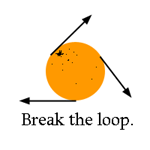

 | Tangentium |
January '05: Menu
All material on this site remains © the original authors: please see our submission guidelines for more information. If no author is shown material is © Drew Whitworth. For any reproduction beyond fair dealing, permission must be sought: e-mail drew@comp.leeds.ac.uk. ISSN number: 1746-4757 |
Access, Communities and Information Technology: Snippets"If there are to be benefits... gained from the development of the information economy, in terms of new training and employment opportunities, improved information, cultural and entertainment services and the ability to use such services in fully interactive ways, then everyone - regardless of whether they personally have a phone, a TV or a computer (or the money to buy one) - must have the right to access these facilities as a public service. The best way of providing such public services will vary enormously from area to area, region to region and country to country." Carter, D. (1997): "'Digital Democracy or 'information aristocracy'?: Economic regeneration and the information economy" in Loader, B. D. (ed.): The Governance of Cyberspace, Routledge, pp. 138-9. [It should be noted that the quote above is immediately followed by examples that, while international, are exclusively urban - the author does not address the particular difficulties faced by rural regions, despite his final sentence.] "While the premise of the BST [Big Sky Telegraph, a Net initiative in rural Montana, US] was that local people could create their own local network and find new ways to empower their local communities and themselves, the impetus for these changes came in part outside the community. After all, knowledge of how to run a Unix server, command of the resources to buy all the modems, the production of the modems themselves, suggest some outside influence.... Outsiders can often command great economic and political forces unavailable to more localised levels, but may not know local or municipal culture.... Developing physical infrastructure is generally something that is not done at local level: outsiders build the roads, whether they are made of pavement or fiber optic cable. Rural regions needed general upgrading of telecommunications facilities, the elimination of multi-party service, lifeline rates, equitable cross-subsidy from immediately profitable urban areas to encourage rural enterprise and the health of the state as a whole, extended service areas that reflect that geographically extended way of life and ultimately the upgrading of line capacity..." Uncapher, W. (1999): "Electronic homesteading on the rural frontier: Big Sky Telegraph and its community" in Smith, M. A. and Kollock, P. (eds.): Communities in Cyberspace, Routledge, pp. 282-3. "Access to hypertext begins with the technology required to read and produce hypertext... Once it becomes widespread enough to serve as a dominant, or at least major, form of publication, issues of the right and power to use such technology will be multiplied. One can easily envision reading a text for which one has only partial permission, so that portions of it remain forbidden, out of sight, and perhaps entirely unknown." Landow, G. P. (1992): Hypertext: The Convergence of Contemporary Critical Theory and Technology, Johns Hopkins, p. 186. "In creating interactive digital environments, the designer's stance is grounded in effective communication. This means more than simply conveying information or doing so in a manner that is persuasive in the narrow sense of seducing or manipulating. It means engaging the intended community of end-users in a lively process of perception, judgment and action." Buchanan, R. (2001): "Good Design in the Digital Age" in Used: Browser 3.0 - the Internet Design Project, Laurence King, p. 16. "A community is bound by place, which always includes complex social and environmental necessities. It is not something you can easily join. You can't subscribe to a community as you subscribe to a discussion group on the net. It must be lived. It is entwined, contradictory, and involves all our senses." Doherty-Farina, S. (1996): The Wired Neighbourhood, Yale UP, p. 37. "The ability to create, maintain and control space... links us to notions of power and necessarily to issues of authority, dominance, submission, rebellion and co-optation, notions Etzioni established as primary criteria and concerns of community. Just because the spaces with which we are concerned are electronic, there is not a guarantee that they are democratic, egalitarian, or accessible..." Jones, S. G. (1998): "Information, Internet and Community: Notes Toward an Understanding of Community in the Information Age" in Jones, S. G. (ed.): Cybersociety 2.0, Sage, p. 20. "Geographical space is more or less divided up, partitioned in one way or another. Certain divisions, certain partitions, are illusory, resulting more from human interpretation than physical realities. But other divisions are based upon undeniable geographical facts." Duverger, M. (1972): The Study of Politics, Nelson, p. 30. | |